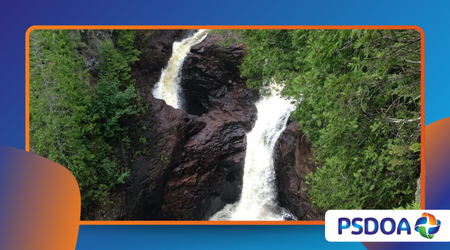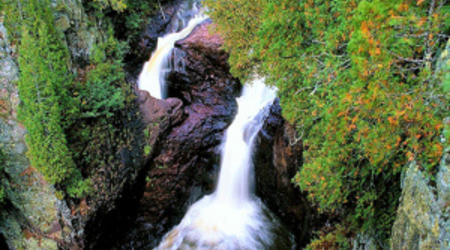The Devil’s Kettle: A Waterfall That Swallows Half Its Flow

The Devil’s Kettle is a geological marvel nestled deep in Judge C. R. Magney State Park in Minnesota. This waterfall has captivated and mystified visitors for generations.
Anúncios
It is a natural feature that seems to violate the basic laws of fluid dynamics. The Brule River, flowing toward Lake Superior, dramatically splits at a massive, unyielding rhyolite rock formation.
The eastern branch tumbles down a normal 50-foot cascade and continues its journey towards the lake. The western branch, however, plunges into a deep, dark pothole the Kettle and vanishes completely from sight.
This baffling hydrological act fueled decades of both folklore and legitimate scientific speculation. Where, precisely, did half of a major river’s flow go?
Popular theories ranged wildly from a massive, undiscovered underground cavern system to a subterranean channel emptying out secretly deep beneath Lake Superior.
Anúncios
Curious visitors and even park rangers famously threw various objects logs, ping-pong balls, brightly colored dyes, and even sophisticated GPS trackers into the seemingly bottomless hole, but strikingly, none of these items were ever observed resurfacing.
This persistent disappearance only deepened the profound enigma of The Devil’s Kettle.
Why is The Devil’s Kettle So Geologically Puzzling?
The enduring allure of this specific site lies in its apparent defiance of common sense and fluid physics. The water enters a contained space, yet it does not appear to exit anywhere visible downstream.
This phenomenon is situated along the rugged, dramatic North Shore of Lake Superior, a region geologically defined by ancient, extremely hard volcanic rock formations.
The intense curiosity surrounding the vanishing water has made Judge C. R. Magney State Park a premier destination for adventurous geotourism.
Hikers willingly undertake the strenuous, difficult trail not just for the stunning natural vista, but specifically to witness this baffling, impossible spectacle: a significant portion of a large river being literally swallowed by the Earth’s solid crust.
++ Penitentes: Blade-Shaped Ice Spikes Found in High-Altitude Regions
What is the Rhyolite Rock and How Does It Create the Mystery?
The entire riverbed around this section is predominantly composed of rhyolite, which is a very hard, igneous volcanic rock, similar in durability to granite.
This dense rock stubbornly resists general erosion, which is the primary factor that forces the powerful Brule River into several narrow, extremely violent chutes and drops.
This specific, resistant geology is actually what prevents the river from simply carving a wide, gentle, and easily understood path.
Instead, the persistent water flow acts less like a river and more like a high-pressure, rotational drill, aggressively scouring out deep, cylindrical, perfectly smooth potholes into the dense rock over countless millennia.
These potholes are precisely where the mystery begins.
Also read: Snow Rollers: Self-Rolling Snowballs Formed by Wind
Why Did the Traditional Tracking Experiments Fail?
The core mystery, which helped establish the enduring legend of The Devil’s Kettle, was cemented by the failure of all attempts to trace the water’s path.
Observers expected an item dropped into the hole to resurface nearby, perhaps just below the main falls. They threw numerous items, but found nothing.
This led to the dramatic conclusion that the water must be flowing miles away through a secret subterranean system.
The lack of an exit point visible on the river’s bank was interpreted as proof that the water must be exiting directly into the massive volume of Lake Superior, where any dye or floating object would be instantly diluted or dispersed without trace.

The Devil’s Kettle Solved: What Does the Science Show?
For years, the public clamored for a concrete explanation, one that could reconcile the river’s flow.
Hydrologists from the Minnesota Department of Natural Resources (DNR) finally provided that definitive, scientific answer in 2017, putting the century-old myth to rest.
The truth is not about a bottomless pit or a secret lake tunnel, but about ingenious fluid dynamics.
The solution was surprisingly straightforward: they employed a precision stream-gauging technique.
This method allowed them to accurately measure the volume of water flowing in the river immediately above the split and compare it to the volume immediately downstream of where the missing water should have returned.
Read more: Sand Falls: Waterfall-Like Motion of Sand in Deserts and Caves
How Does Stream-Gauging Prove the Water Re-Emerges?
In their study, hydrologists measured the flow rate above the falls at approximately 123 cubic feet per second (cfs).
The crucial measurement came below the falls, where the river had completely reconsolidated. The recorded downstream flow rate was 121 cfs.
The Minnesota DNR found the water flow rate difference was less than 2% between the points above and below the falls.
According to DNR hydrologist Jeff Green, in the specialized field of stream gauging, a difference of only two percent is considered virtually identical; it falls well within the normal error margin of the equipment.
This data conclusively demonstrated that absolutely no water was being lost to a secret lake tunnel or a deep cavern.
All the water that vanished into The Devil’s Kettle was, in fact, rejoining the Brule River stream, just moments later, from an unseen underwater crevice.
Why Did Objects Disappear and Never Resurface?
If the water is simply rejoining the river, why did the countless logs, dyes, and trackers never reappear?
The answer lies in the sheer, overwhelming power of the hidden hydraulic system. The force of the water inside the kettle is not just strong; it’s violent.
Imagine the water entering The Devil’s Kettle not as a gentle stream, but as a giant, high-speed cement mixer.
Anything dropped into the hole is subjected to an unbelievably powerful system of recirculating, crushing currents.
These forces are capable of holding materials under water until they are physically disintegrated, pulverized into tiny, unrecognizable fragments, or simply turned to pulp.
A ping-pong ball would be instantly smashed; a dye pack would be diluted beyond detection within the churning water column before it ever exited.
How Does the Underground Plumbing Work?
The specific geology of the rhyolite rock, while too hard to form typical limestone caves, is not impenetrable.
The tremendous energy of the falling water has, over eons, exploited existing fractures and weaknesses in the hard rock. These fractures are the river’s subterranean secret passage.
The water does not travel through a large, open cave system, as originally speculated. Instead, it is forced through a constricted, high-pressure network of pre-existing cracks and fault lines.
This tight squeeze maintains the immense velocity and pressure that explains the total destruction of any object dropped into the pothole.
Where Exactly Does the Water Rejoin the River?
While the DNR confirmed the water returns, the exact subterranean exit point remains challenging to precisely pinpoint.
Researchers believe the water emerges through a submerged fissure or crack located directly in the riverbed, likely very close to the base of the main waterfall. The re-emergence is completely underwater.
This submerged exit is critical to the mystery. The speed and turbulence of the river at the base of the falls are so intense that the flow from the fissure is immediately masked.
It is seamlessly integrated back into the river flow without creating any distinct, visible bubbling or tell-tale plume.
Is This Phenomenon Common in Other River Systems?
Waterfalls where the flow splits and vanishes are incredibly rare, making The Devil’s Kettle truly unique in its manifestation.
Such phenomena require the perfect confluence of extremely hard, fractured rock, a high volume of water, and an acute change in elevation.
The closest comparison might be to karst environments, where rivers disappear into “swallow holes” (sinkholes) within porous limestone, only to emerge miles away.
However, the geology of the Kettle is rhyolite, making the underground plumbing system fundamentally different: it’s fracture-driven, not dissolution-driven.
This distinction is what makes the Minnesota site a singular oddity in natural hydrology.
| Object Dropped | Hypothetical Outcome (Pre-2017 Myth) | Actual Scientific Outcome (Post-2017) |
| Log | Emerge in Lake Superior miles away. | Pulverized and held underwater until completely degraded. |
| Dye | Create a visible plume in the river or lake. | Diluted immediately by intense subterranean churning. |
| GPS Tracker | Transmit a signal from an underground fault. | Smashed, filling with water, and sinking permanently into the plunge pool debris. |
Conclusion: The Magic Persists Beyond the Science
The definitive scientific explanation that the water merely takes a secret, submerged shortcut back to the river removed the mystery of where the water goes, but it did not diminish the wonder.
The Devil’s Kettle remains a compelling demonstration of nature’s power to carve astonishing features into the hardest rock. It is a stunning, real-world example of hydraulics and geology in a permanent, violent embrace.
Understanding the mechanics the high-pressure tunnels and the pulverizing forces actually enhances our respect for this natural spectacle.
It transforms the site from a myth into a profound, accessible lesson in Earth science. The powerful currents may destroy sticks and dyes, but they preserve the magic of a river that seems to disappear.
We know the answer now, but witnessing the void still prompts the same primal human question: What wonders does the Earth hold that we still don’t fully see?
Share your thoughts and memories of visiting the falls, or your own favorite natural enigma, in the comments below!
Frequently Asked Questions
Why couldn’t scientists just use colored dye to find the exit point?
Scientists did intend to use biodegradable, fluorescent dye. However, the powerful, highly turbulent flow within the constricted subterranean system would dilute any dye almost instantly.
The re-emergence would likely be so dispersed that it would be visually undetectable in the fast-moving river below the main falls.
Is The Devil’s Kettle a safe place to visit?
The area around the waterfall itself is protected and relatively safe, with viewing platforms and railings. However, the Brule River’s current is extremely powerful and the rocks are often slippery.
Visitors are strictly warned to stay on marked trails and absolutely never attempt to climb near the edge or throw anything into the hole due to the risk of a fatal slip.
What is the geological term for the Kettle’s formation?
The feature is an unusually large and deep pothole (or “plunge pool”), which is a naturally occurring, smooth, cylindrical depression in a riverbed.
Potholes are eroded by the swirling action of water and abrasive sediment (like sand and pebbles) over vast periods of time.
How much water is estimated to be flowing into the hole?
Although the river splits, the volume of water entering the Kettle can vary significantly depending on the season and rainfall.
However, based on the DNR’s measurements, approximately half of the Brule River’s total flow plunges into The Devil’s Kettle at the split point.
Has anyone ever attempted to explore the inside of the Kettle?
Due to the extremely dangerous, high-pressure, recirculating currents, the immediate area around the Kettle is considered far too hazardous for human exploration.
The powerful forces inside would be instantly fatal, making any attempt at diving or descending technologically and humanly impossible.
